title: Netty02-入门
top: false
cover: true
author: 张文军
date: 2021-04-12 05:36:46
tags:
- 网络
- netty
category: - netty
- 网络
summary: Netty02-入门

锁清秋
二. Netty 入门
1. 概述
1.1 Netty 是什么?
Netty is an asynchronous event-driven network application frameworkfor rapid development of maintainable high performance protocol servers & clients.
Netty 是一个异步的、基于事件驱动的网络应用框架,用于快速开发可维护、高性能的网络服务器和客户端
1.2 Netty 的作者

他还是另一个著名网络应用框架 Mina 的重要贡献者
1.3 Netty 的地位
Netty 在 Java 网络应用框架中的地位就好比:Spring 框架在 JavaEE 开发中的地位
以下的框架都使用了 Netty,因为它们有网络通信需求!
- Cassandra - nosql 数据库
- Spark - 大数据分布式计算框架
- Hadoop - 大数据分布式存储框架
- RocketMQ - ali 开源的消息队列
- ElasticSearch - 搜索引擎
- gRPC - rpc 框架
- Dubbo - rpc 框架
- Spring 5.x - flux api 完全抛弃了 tomcat ,使用 netty 作为服务器端
Zookeeper - 分布式协调框架
1.4 Netty 的优势
Netty vs NIO,工作量大,bug 多
- 需要自己构建协议
- 解决 TCP 传输问题,如粘包、半包
- epoll 空轮询导致 CPU 100%
- 对 API 进行增强,使之更易用,如 FastThreadLocal => ThreadLocal,ByteBuf => ByteBuffer
- Netty vs 其它网络应用框架
- Mina 由 apache 维护,将来 3.x 版本可能会有较大重构,破坏 API 向下兼容性,Netty 的开发迭代更迅速,API 更简洁、文档更优秀
- 久经考验,16年,Netty 版本
- 2.x 2004
- 3.x 2008
- 4.x 2013
- 5.x 已废弃(没有明显的性能提升,维护成本高)
2. Hello World
2.1 目标
开发一个简单的服务器端和客户端
- 客户端向服务器端发送 hello, world
- 服务器仅接收,不返回
加入依赖
<dependency><groupId>io.netty</groupId><artifactId>netty-all</artifactId><version>4.1.39.Final</version></dependency>
2.2 服务器端
new ServerBootstrap().group(new NioEventLoopGroup()) // 1.channel(NioServerSocketChannel.class) // 2.childHandler(new ChannelInitializer<NioSocketChannel>() { // 3protected void initChannel(NioSocketChannel ch) {ch.pipeline().addLast(new StringDecoder()); // 5ch.pipeline().addLast(new SimpleChannelInboundHandler<String>() { // 6@Overrideprotected void channelRead0(ChannelHandlerContext ctx, String msg) {System.out.println(msg);}});}}).bind(8080); // 4
代码解读
- 1 处,创建 NioEventLoopGroup,可以简单理解为
线程池 + Selector后面会详细展开
- 2 处,选择服务 Scoket 实现类,其中 NioServerSocketChannel 表示基于 NIO 的服务器端实现,其它实现还有

- 3 处,为啥方法叫 childHandler,是接下来添加的处理器都是给 SocketChannel 用的,而不是给 ServerSocketChannel。ChannelInitializer 处理器(仅执行一次),它的作用是待客户端 SocketChannel 建立连接后,执行 initChannel 以便添加更多的处理器
- 4 处,ServerSocketChannel 绑定的监听端口
- 5 处,SocketChannel 的处理器,解码 ByteBuf => String
- 6 处,SocketChannel 的业务处理器,使用上一个处理器的处理结果
2.3 客户端
new Bootstrap().group(new NioEventLoopGroup()) // 1.channel(NioSocketChannel.class) // 2.handler(new ChannelInitializer<Channel>() { // 3@Overrideprotected void initChannel(Channel ch) {ch.pipeline().addLast(new StringEncoder()); // 8}}).connect("127.0.0.1", 8080) // 4.sync() // 5.channel() // 6.writeAndFlush(new Date() + ": hello world!"); // 7
代码解读
- 1 处,创建 NioEventLoopGroup,同 Server
- 2 处,选择客户 Socket 实现类,NioSocketChannel 表示基于 NIO 的客户端实现,其它实现还有

- 3 处,添加 SocketChannel 的处理器,ChannelInitializer 处理器(仅执行一次),它的作用是待客户端 SocketChannel 建立连接后,执行 initChannel 以便添加更多的处理器
- 4 处,指定要连接的服务器和端口
- 5 处,Netty 中很多方法都是异步的,如 connect,这时需要使用 sync 方法等待 connect 建立连接完毕
- 6 处,获取 channel 对象,它即为通道抽象,可以进行数据读写操作
- 7 处,写入消息并清空缓冲区
- 8 处,消息会经过通道 handler 处理,这里是将 String => ByteBuf 发出
- 数据经过网络传输,到达服务器端,服务器端 5 和 6 处的 handler 先后被触发,走完一个流程
2.4 流程梳理
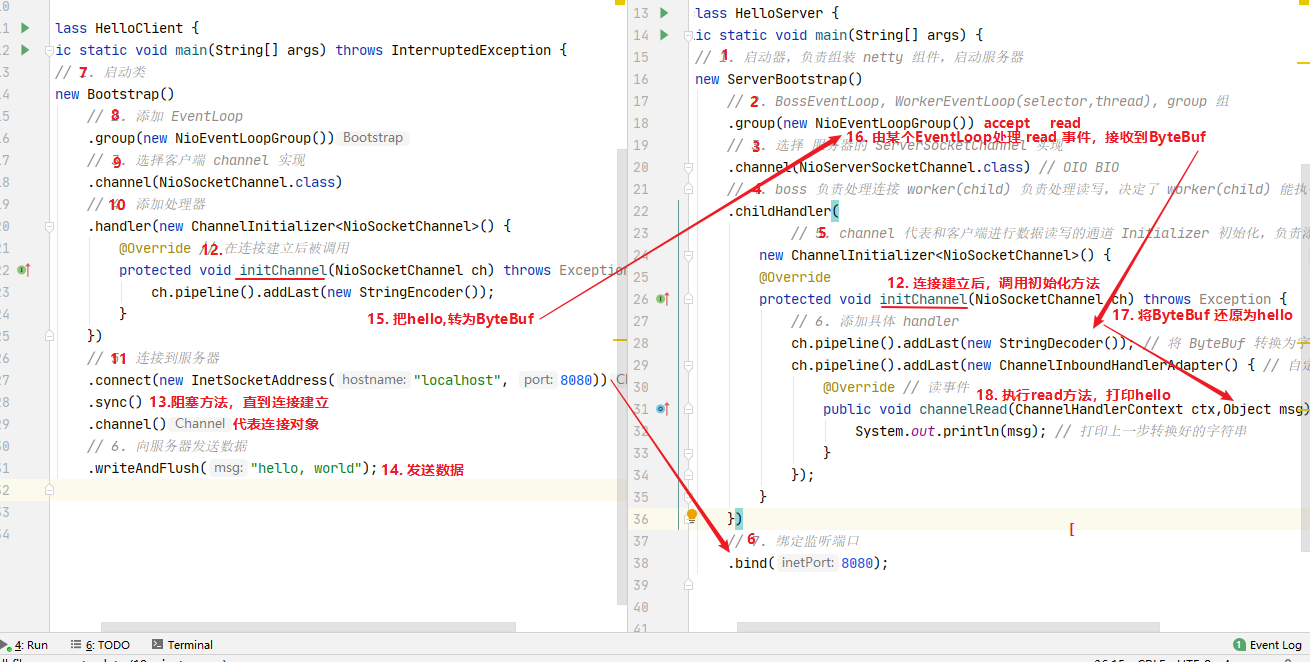
💡 提示
一开始需要树立正确的观念
- 把 channel 理解为数据的通道
- 把 msg 理解为流动的数据,最开始输入是 ByteBuf,但经过 pipeline 的加工,会变成其它类型对象,最后输出又变成 ByteBuf
- 把 handler 理解为数据的处理工序
- 工序有多道,合在一起就是 pipeline,pipeline 负责发布事件(读、读取完成…)传播给每个 handler, handler 对自己感兴趣的事件进行处理(重写了相应事件处理方法)
- handler 分 Inbound 和 Outbound 两类
- 把 eventLoop 理解为处理数据的工人
- 工人可以管理多个 channel 的 io 操作,并且一旦工人负责了某个 channel,就要负责到底(绑定)
- 工人既可以执行 io 操作,也可以进行任务处理,每位工人有任务队列,队列里可以堆放多个 channel 的待处理任务,任务分为普通任务、定时任务
- 工人按照 pipeline 顺序,依次按照 handler 的规划(代码)处理数据,可以为每道工序指定不同的工人
3. 组件
3.1 EventLoop
事件循环对象
EventLoop 本质是一个单线程执行器(同时维护了一个 Selector),里面有 run 方法处理 Channel 上源源不断的 io 事件。
它的继承关系比较复杂
- 一条线是继承自 j.u.c.ScheduledExecutorService 因此包含了线程池中所有的方法
- 另一条线是继承自 netty 自己的 OrderedEventExecutor,
- 提供了 boolean inEventLoop(Thread thread) 方法判断一个线程是否属于此 EventLoop
- 提供了 parent 方法来看看自己属于哪个 EventLoopGroup
事件循环组
EventLoopGroup 是一组 EventLoop,Channel 一般会调用 EventLoopGroup 的 register 方法来绑定其中一个 EventLoop,后续这个 Channel 上的 io 事件都由此 EventLoop 来处理(保证了 io 事件处理时的线程安全)
- 继承自 netty 自己的 EventExecutorGroup
- 实现了 Iterable 接口提供遍历 EventLoop 的能力
- 另有 next 方法获取集合中下一个 EventLoop
以一个简单的实现为例:
// 内部创建了两个 EventLoop, 每个 EventLoop 维护一个线程DefaultEventLoopGroup group = new DefaultEventLoopGroup(2);System.out.println(group.next());System.out.println(group.next());System.out.println(group.next());
输出
io.netty.channel.DefaultEventLoop@60f82f98io.netty.channel.DefaultEventLoop@35f983a6io.netty.channel.DefaultEventLoop@60f82f98
也可以使用 for 循环
DefaultEventLoopGroup group = new DefaultEventLoopGroup(2);for (EventExecutor eventLoop : group) {System.out.println(eventLoop);}
输出
io.netty.channel.DefaultEventLoop@60f82f98io.netty.channel.DefaultEventLoop@35f983a6
💡 优雅关闭
优雅关闭 shutdownGracefully 方法。该方法会首先切换 EventLoopGroup 到关闭状态从而拒绝新的任务的加入,然后在任务队列的任务都处理完成后,停止线程的运行。从而确保整体应用是在正常有序的状态下退出的
演示 NioEventLoop 处理 io 事件
服务器端两个 nio worker 工人
new ServerBootstrap().group(new NioEventLoopGroup(1), new NioEventLoopGroup(2)).channel(NioServerSocketChannel.class).childHandler(new ChannelInitializer<NioSocketChannel>() {@Overrideprotected void initChannel(NioSocketChannel ch) {ch.pipeline().addLast(new ChannelInboundHandlerAdapter() {@Overridepublic void channelRead(ChannelHandlerContext ctx, Object msg) {ByteBuf byteBuf = msg instanceof ByteBuf ? ((ByteBuf) msg) : null;if (byteBuf != null) {byte[] buf = new byte[16];ByteBuf len = byteBuf.readBytes(buf, 0, byteBuf.readableBytes());log.debug(new String(buf));}}});}}).bind(8080).sync();
客户端,启动三次,分别修改发送字符串为 zhangsan(第一次),lisi(第二次),wangwu(第三次)
public static void main(String[] args) throws InterruptedException {Channel channel = new Bootstrap().group(new NioEventLoopGroup(1)).handler(new ChannelInitializer<NioSocketChannel>() {@Overrideprotected void initChannel(NioSocketChannel ch) throws Exception {System.out.println("init...");ch.pipeline().addLast(new LoggingHandler(LogLevel.DEBUG));}}).channel(NioSocketChannel.class).connect("localhost", 8080).sync().channel();channel.writeAndFlush(ByteBufAllocator.DEFAULT.buffer().writeBytes("wangwu".getBytes()));Thread.sleep(2000);channel.writeAndFlush(ByteBufAllocator.DEFAULT.buffer().writeBytes("wangwu".getBytes()));
最后输出
22:03:34 [DEBUG] [nioEventLoopGroup-3-1] c.i.o.EventLoopTest - zhangsan22:03:36 [DEBUG] [nioEventLoopGroup-3-1] c.i.o.EventLoopTest - zhangsan22:05:36 [DEBUG] [nioEventLoopGroup-3-2] c.i.o.EventLoopTest - lisi22:05:38 [DEBUG] [nioEventLoopGroup-3-2] c.i.o.EventLoopTest - lisi22:06:09 [DEBUG] [nioEventLoopGroup-3-1] c.i.o.EventLoopTest - wangwu22:06:11 [DEBUG] [nioEventLoopGroup-3-1] c.i.o.EventLoopTest - wangwu
可以看到两个工人轮流处理 channel,但工人与 channel 之间进行了绑定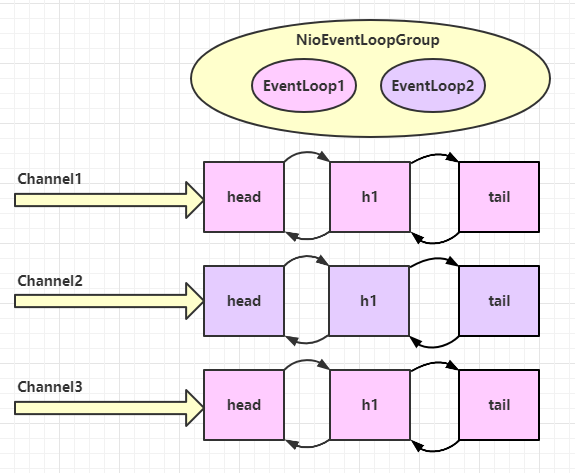
再增加两个非 nio 工人
DefaultEventLoopGroup normalWorkers = new DefaultEventLoopGroup(2);new ServerBootstrap().group(new NioEventLoopGroup(1), new NioEventLoopGroup(2)).channel(NioServerSocketChannel.class).childHandler(new ChannelInitializer<NioSocketChannel>() {@Overrideprotected void initChannel(NioSocketChannel ch) {ch.pipeline().addLast(new LoggingHandler(LogLevel.DEBUG));ch.pipeline().addLast(normalWorkers,"myhandler",new ChannelInboundHandlerAdapter() {@Overridepublic void channelRead(ChannelHandlerContext ctx, Object msg) {ByteBuf byteBuf = msg instanceof ByteBuf ? ((ByteBuf) msg) : null;if (byteBuf != null) {byte[] buf = new byte[16];ByteBuf len = byteBuf.readBytes(buf, 0, byteBuf.readableBytes());log.debug(new String(buf));}}});}}).bind(8080).sync();
客户端代码不变,启动三次,分别修改发送字符串为 zhangsan(第一次),lisi(第二次),wangwu(第三次)
输出
22:19:48 [DEBUG] [nioEventLoopGroup-4-1] i.n.h.l.LoggingHandler - [id: 0x251562d5, L:/127.0.0.1:8080 - R:/127.0.0.1:52588] REGISTERED22:19:48 [DEBUG] [nioEventLoopGroup-4-1] i.n.h.l.LoggingHandler - [id: 0x251562d5, L:/127.0.0.1:8080 - R:/127.0.0.1:52588] ACTIVE22:19:48 [DEBUG] [nioEventLoopGroup-4-1] i.n.h.l.LoggingHandler - [id: 0x251562d5, L:/127.0.0.1:8080 - R:/127.0.0.1:52588] READ: 8B+-------------------------------------------------+| 0 1 2 3 4 5 6 7 8 9 a b c d e f |+--------+-------------------------------------------------+----------------+|00000000| 7a 68 61 6e 67 73 61 6e |zhangsan |+--------+-------------------------------------------------+----------------+22:19:48 [DEBUG] [nioEventLoopGroup-4-1] i.n.h.l.LoggingHandler - [id: 0x251562d5, L:/127.0.0.1:8080 - R:/127.0.0.1:52588] READ COMPLETE22:19:48 [DEBUG] [defaultEventLoopGroup-2-1] c.i.o.EventLoopTest - zhangsan22:19:50 [DEBUG] [nioEventLoopGroup-4-1] i.n.h.l.LoggingHandler - [id: 0x251562d5, L:/127.0.0.1:8080 - R:/127.0.0.1:52588] READ: 8B+-------------------------------------------------+| 0 1 2 3 4 5 6 7 8 9 a b c d e f |+--------+-------------------------------------------------+----------------+|00000000| 7a 68 61 6e 67 73 61 6e |zhangsan |+--------+-------------------------------------------------+----------------+22:19:50 [DEBUG] [nioEventLoopGroup-4-1] i.n.h.l.LoggingHandler - [id: 0x251562d5, L:/127.0.0.1:8080 - R:/127.0.0.1:52588] READ COMPLETE22:19:50 [DEBUG] [defaultEventLoopGroup-2-1] c.i.o.EventLoopTest - zhangsan22:20:24 [DEBUG] [nioEventLoopGroup-4-2] i.n.h.l.LoggingHandler - [id: 0x94b2a840, L:/127.0.0.1:8080 - R:/127.0.0.1:52612] REGISTERED22:20:24 [DEBUG] [nioEventLoopGroup-4-2] i.n.h.l.LoggingHandler - [id: 0x94b2a840, L:/127.0.0.1:8080 - R:/127.0.0.1:52612] ACTIVE22:20:25 [DEBUG] [nioEventLoopGroup-4-2] i.n.h.l.LoggingHandler - [id: 0x94b2a840, L:/127.0.0.1:8080 - R:/127.0.0.1:52612] READ: 4B+-------------------------------------------------+| 0 1 2 3 4 5 6 7 8 9 a b c d e f |+--------+-------------------------------------------------+----------------+|00000000| 6c 69 73 69 |lisi |+--------+-------------------------------------------------+----------------+22:20:25 [DEBUG] [nioEventLoopGroup-4-2] i.n.h.l.LoggingHandler - [id: 0x94b2a840, L:/127.0.0.1:8080 - R:/127.0.0.1:52612] READ COMPLETE22:20:25 [DEBUG] [defaultEventLoopGroup-2-2] c.i.o.EventLoopTest - lisi22:20:27 [DEBUG] [nioEventLoopGroup-4-2] i.n.h.l.LoggingHandler - [id: 0x94b2a840, L:/127.0.0.1:8080 - R:/127.0.0.1:52612] READ: 4B+-------------------------------------------------+| 0 1 2 3 4 5 6 7 8 9 a b c d e f |+--------+-------------------------------------------------+----------------+|00000000| 6c 69 73 69 |lisi |+--------+-------------------------------------------------+----------------+22:20:27 [DEBUG] [nioEventLoopGroup-4-2] i.n.h.l.LoggingHandler - [id: 0x94b2a840, L:/127.0.0.1:8080 - R:/127.0.0.1:52612] READ COMPLETE22:20:27 [DEBUG] [defaultEventLoopGroup-2-2] c.i.o.EventLoopTest - lisi22:20:38 [DEBUG] [nioEventLoopGroup-4-1] i.n.h.l.LoggingHandler - [id: 0x79a26af9, L:/127.0.0.1:8080 - R:/127.0.0.1:52625] REGISTERED22:20:38 [DEBUG] [nioEventLoopGroup-4-1] i.n.h.l.LoggingHandler - [id: 0x79a26af9, L:/127.0.0.1:8080 - R:/127.0.0.1:52625] ACTIVE22:20:38 [DEBUG] [nioEventLoopGroup-4-1] i.n.h.l.LoggingHandler - [id: 0x79a26af9, L:/127.0.0.1:8080 - R:/127.0.0.1:52625] READ: 6B+-------------------------------------------------+| 0 1 2 3 4 5 6 7 8 9 a b c d e f |+--------+-------------------------------------------------+----------------+|00000000| 77 61 6e 67 77 75 |wangwu |+--------+-------------------------------------------------+----------------+22:20:38 [DEBUG] [nioEventLoopGroup-4-1] i.n.h.l.LoggingHandler - [id: 0x79a26af9, L:/127.0.0.1:8080 - R:/127.0.0.1:52625] READ COMPLETE22:20:38 [DEBUG] [defaultEventLoopGroup-2-1] c.i.o.EventLoopTest - wangwu22:20:40 [DEBUG] [nioEventLoopGroup-4-1] i.n.h.l.LoggingHandler - [id: 0x79a26af9, L:/127.0.0.1:8080 - R:/127.0.0.1:52625] READ: 6B+-------------------------------------------------+| 0 1 2 3 4 5 6 7 8 9 a b c d e f |+--------+-------------------------------------------------+----------------+|00000000| 77 61 6e 67 77 75 |wangwu |+--------+-------------------------------------------------+----------------+22:20:40 [DEBUG] [nioEventLoopGroup-4-1] i.n.h.l.LoggingHandler - [id: 0x79a26af9, L:/127.0.0.1:8080 - R:/127.0.0.1:52625] READ COMPLETE22:20:40 [DEBUG] [defaultEventLoopGroup-2-1] c.i.o.EventLoopTest - wangwu
可以看到,nio 工人和 非 nio 工人也分别绑定了 channel(LoggingHandler 由 nio 工人执行,而我们自己的 handler 由非 nio 工人执行)
💡 handler 执行中如何换人?
关键代码 io.netty.channel.AbstractChannelHandlerContext#invokeChannelRead()
static void invokeChannelRead(final AbstractChannelHandlerContext next, Object msg) {final Object m = next.pipeline.touch(ObjectUtil.checkNotNull(msg, "msg"), next);// 下一个 handler 的事件循环是否与当前的事件循环是同一个线程EventExecutor executor = next.executor();// 是,直接调用if (executor.inEventLoop()) {next.invokeChannelRead(m);}// 不是,将要执行的代码作为任务提交给下一个事件循环处理(换人)else {executor.execute(new Runnable() {@Overridepublic void run() {next.invokeChannelRead(m);}});}}
- 如果两个 handler 绑定的是同一个线程,那么就直接调用
- 否则,把要调用的代码封装为一个任务对象,由下一个 handler 的线程来调用
演示 NioEventLoop 处理普通任务
NioEventLoop 除了可以处理 io 事件,同样可以向它提交普通任务 ``` NioEventLoopGroup nioWorkers = new NioEventLoopGroup(2);
log.debug(“server start…”); Thread.sleep(2000); nioWorkers.execute(()->{ log.debug(“normal task…”); });
输出
22:30:36 [DEBUG] [main] c.i.o.EventLoopTest2 - server start… 22:30:38 [DEBUG] [nioEventLoopGroup-2-1] c.i.o.EventLoopTest2 - normal task…
> 可以用来执行耗时较长的任务#### 演示 NioEventLoop 处理定时任务
NioEventLoopGroup nioWorkers = new NioEventLoopGroup(2);
log.debug(“server start…”); Thread.sleep(2000); nioWorkers.scheduleAtFixedRate(() -> { log.debug(“running…”); }, 0, 1, TimeUnit.SECONDS);
输出
22:35:15 [DEBUG] [main] c.i.o.EventLoopTest2 - server start… 22:35:17 [DEBUG] [nioEventLoopGroup-2-1] c.i.o.EventLoopTest2 - running… 22:35:18 [DEBUG] [nioEventLoopGroup-2-1] c.i.o.EventLoopTest2 - running… 22:35:19 [DEBUG] [nioEventLoopGroup-2-1] c.i.o.EventLoopTest2 - running… 22:35:20 [DEBUG] [nioEventLoopGroup-2-1] c.i.o.EventLoopTest2 - running… …
> 可以用来执行定时任务### 3.2 Channelchannel 的主要作用- close() 可以用来关闭 channel- closeFuture() 用来处理 channel 的关闭- sync 方法作用是同步等待 channel 关闭- 而 addListener 方法是异步等待 channel 关闭- pipeline() 方法添加处理器- write() 方法将数据写入- writeAndFlush() 方法将数据写入并刷出#### ChannelFuture这时刚才的客户端代码
new Bootstrap()
.group(new NioEventLoopGroup())
.channel(NioSocketChannel.class)
.handler(new ChannelInitializer
现在把它拆开来看
ChannelFuture channelFuture = new Bootstrap()
.group(new NioEventLoopGroup())
.channel(NioSocketChannel.class)
.handler(new ChannelInitializer
channelFuture.sync().channel().writeAndFlush(new Date() + “: hello world!”);
- 1 处返回的是 ChannelFuture 对象,它的作用是利用 channel() 方法来获取 Channel 对象**注意** connect 方法是异步的,意味着不等连接建立,方法执行就返回了。因此 channelFuture 对象中不能【立刻】获得到正确的 Channel 对象<br />实验如下:
ChannelFuture channelFuture = new Bootstrap()
.group(new NioEventLoopGroup())
.channel(NioSocketChannel.class)
.handler(new ChannelInitializer
System.out.println(channelFuture.channel()); // 1 channelFuture.sync(); // 2 System.out.println(channelFuture.channel()); // 3
- 执行到 1 时,连接未建立,打印 `[id: 0x2e1884dd]`- 执行到 2 时,sync 方法是同步等待连接建立完成- 执行到 3 时,连接肯定建立了,打印 `[id: 0x2e1884dd, L:/127.0.0.1:57191 - R:/127.0.0.1:8080]`除了用 sync 方法可以让异步操作同步以外,还可以使用回调的方式:
ChannelFuture channelFuture = new Bootstrap()
.group(new NioEventLoopGroup())
.channel(NioSocketChannel.class)
.handler(new ChannelInitializer
- 执行到 1 时,连接未建立,打印 `[id: 0x749124ba]`- ChannelFutureListener 会在连接建立时被调用(其中 operationComplete 方法),因此执行到 2 时,连接肯定建立了,打印 `[id: 0x749124ba, L:/127.0.0.1:57351 - R:/127.0.0.1:8080]`#### CloseFuture
@Slf4j
public class CloseFutureClient {
public static void main(String[] args) throws InterruptedException {
NioEventLoopGroup group new NioEventLoopGroup();
ChannelFuture channelFuture = new Bootstrap()
.group(group)
.channel(NioSocketChannel.class)
.handler(new ChannelInitializer
// 获取 CloseFuture 对象, 1) 同步处理关闭, 2) 异步处理关闭ChannelFuture closeFuture = channel.closeFuture();/*log.debug("waiting close...");closeFuture.sync();log.debug("处理关闭之后的操作");*/closeFuture.addListener(new ChannelFutureListener() {@Overridepublic void operationComplete(ChannelFuture future) throws Exception {log.debug("处理关闭之后的操作");group.shutdownGracefully();}});}
}
#### 💡 异步提升的是什么-有些同学看到这里会有疑问:为什么不在一个线程中去执行建立连接、去执行关闭 channel,那样不是也可以吗?非要用这么复杂的异步方式:比如一个线程发起建立连接,另一个线程去真正建立连接-还有同学会笼统地回答,因为 netty 异步方式用了多线程、多线程就效率高。其实这些认识都比较片面,多线程和异步所提升的效率并不是所认为的思考下面的场景,4 个医生给人看病,每个病人花费 20 分钟,而且医生看病的过程中是以病人为单位的,一个病人看完了,才能看下一个病人。假设病人源源不断地来,可以计算一下 4 个医生一天工作 8 小时,处理的病人总数是:`4 * 8 * 3 = 96`<br />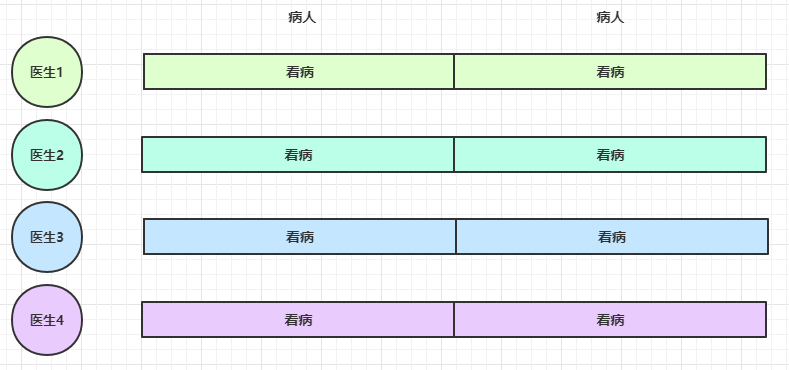<br />经研究发现,看病可以细分为四个步骤,经拆分后每个步骤需要 5 分钟,如下<br />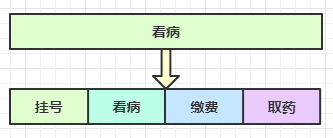<br />因此可以做如下优化,只有一开始,医生 2、3、4 分别要等待 5、10、15 分钟才能执行工作,但只要后续病人源源不断地来,他们就能够满负荷工作,并且处理病人的能力提高到了 `4 * 8 * 12` 效率几乎是原来的四倍<br />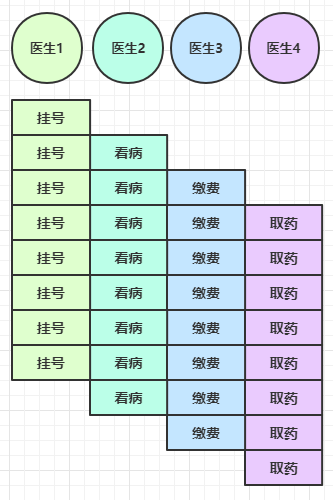<br />要点- 单线程没法异步提高效率,必须配合多线程、多核 cpu 才能发挥异步的优势- 异步并没有缩短响应时间,反而有所增加- 合理进行任务拆分,也是利用异步的关键# **ChannelFuture**接口## ChannelFuture介绍**Future**最早出现于JDK的java.util.concurrent.Future,它用于表示异步操作的结果.由于Netty的**Future**都是与异步I/O操作相关的,因此命名为**ChannelFuture**,代表它与Channel操作相关.<br />由于Netty中的所有I / O操作都是异步的,因此Netty为了解决调用者如何获取异步操作结果的问题而专门设计了**ChannelFuture**接口.<br />因此,**Channel**与**ChannelFuture**可以说形影不离的.## ChannelFuture的状态ChannelFuture有两种状态:未完成(uncompleted)和完成(completed).<br />当令Channel开始一个I/O操作时,会创建一个新的ChannelFuture去异步完成操作.<br />被创建时的ChannelFuture处于uncompleted状态(非失败,非成功,非取消);一旦ChannelFuture完成I/O操作,ChannelFuture将处于completed状态,结果可能有三种:1. 操作成功1. 操作失败1. 操作被取消(I/O操作被主动终止)下图是 Netty API 中提供的ChannelFuture状态迁移图:
+---------------------------+| Completed successfully |+---------------------------++----> isDone() = true |
+—————————————+ | | isSuccess() = true | | Uncompleted | | +===========================+ +—————————————+ | | Completed with failure | | isDone() = false | | +—————————————-+ | isSuccess() = false |——+——> isDone() = true | | isCancelled() = false | | | cause() = non-null | | cause() = null | | +===========================+ +—————————————+ | | Completed by cancellation | | +—————————————-+ +——> isDone() = true | | isCancelled() = true | +—————————————-+
## GenericFutureListener监听接口虽然可以通过ChannelFuture的get()方法获取异步操作的结果,但完成时间是无法预测的,若不设置超时时间则有可能导致线程长时间被阻塞;若是不能精确的设置超时时间则可能导致I/O操作中断.因此,Netty建议通过GenericFutureListener接口执行异步操作结束后的回调.<br />Netty API 中使用的GenericFutureListener示例代码:<br />虽然可以通过ChannelFuture的get()方法获取异步操作的结果,但完成时间是无法预测的,若不设置超时时间则有可能导致线程长时间被阻塞;若是不能精确的设置超时时间则可能导致I/O操作中断.因此,Netty建议通过GenericFutureListener接口执行异步操作结束后的回调.<br />Netty API 中使用的GenericFutureListener示例代码:
@Override public void channelRead(ChannelHandlerContext ctx, Object msg) { ChannelFuture future = ctx.channel().close(); future.addListener(new ChannelFutureListener() { public void operationComplete(ChannelFuture future) { // Perform post-closure operation // … } }); }
另外,**ChannelFuture**允许添加一个或多个(移除一个或多个)**GenericFutureListener**监听接口,方法名:`addListener()`, `addListeners()`, `removeListener()`, `removeListeners()`.### 3.3 Future & Promise在异步处理时,经常用到这两个接口<br />首先要说明 netty 中的 Future 与 jdk 中的 Future 同名,但是是两个接口,netty 的 Future 继承自 jdk 的 Future,而 Promise 又对 netty Future 进行了扩展- jdk Future 只能同步等待任务结束(或成功、或失败)才能得到结果- netty Future 可以同步等待任务结束得到结果,也可以异步方式得到结果,但都是要等任务结束- netty Promise 不仅有 netty Future 的功能,而且脱离了任务独立存在,只作为两个线程间传递结果的容器|功能/名称| jdk Future| netty Future| Promise|| --- | --- | --- | --- ||cancel| 取消任务| -| -||isCanceled| 任务是否取消| -| -||isDone| 任务是否完成,不能区分成功失败| -| -||get| 获取任务结果,阻塞等待| -| -||getNow| -| 获取任务结果,非阻塞,还未产生结果时返回 null| -||await| -| 等待任务结束,如果任务失败,不会抛异常,而是通过 isSuccess 判断| -||sync| -| 等待任务结束,如果任务失败,抛出异常| -||isSuccess| -| 判断任务是否成功| -||cause| -| 获取失败信息,非阻塞,如果没有失败,返回null| -||addLinstener| -| 添加回调,异步接收结果| -||setSuccess| -| -| 设置成功结果||setFailure| -| -| 设置失败结果|#### 例1同步处理任务成功
DefaultEventLoop eventExecutors = new DefaultEventLoop();
DefaultPromise
eventExecutors.execute(()->{ try { Thread.sleep(1000); } catch (InterruptedException e) { e.printStackTrace(); } log.debug(“set success, {}”,10); promise.setSuccess(10); });
log.debug(“start…”); log.debug(“{}”,promise.getNow()); // 还没有结果 log.debug(“{}”,promise.get());
输出
11:51:53 [DEBUG] [main] c.i.o.DefaultPromiseTest2 - start… 11:51:53 [DEBUG] [main] c.i.o.DefaultPromiseTest2 - null 11:51:54 [DEBUG] [defaultEventLoop-1-1] c.i.o.DefaultPromiseTest2 - set success, 10 11:51:54 [DEBUG] [main] c.i.o.DefaultPromiseTest2 - 10
#### 例2异步处理任务成功
DefaultEventLoop eventExecutors = new DefaultEventLoop();
DefaultPromise
// 设置回调,异步接收结果 promise.addListener(future -> { // 这里的 future 就是上面的 promise log.debug(“{}”,future.getNow()); });
// 等待 1000 后设置成功结果 eventExecutors.execute(()->{ try { Thread.sleep(1000); } catch (InterruptedException e) { e.printStackTrace(); } log.debug(“set success, {}”,10); promise.setSuccess(10); });
log.debug(“start…”);
输出
11:49:30 [DEBUG] [main] c.i.o.DefaultPromiseTest2 - start… 11:49:31 [DEBUG] [defaultEventLoop-1-1] c.i.o.DefaultPromiseTest2 - set success, 10 11:49:31 [DEBUG] [defaultEventLoop-1-1] c.i.o.DefaultPromiseTest2 - 10
#### 例3同步处理任务失败 - sync & get
DefaultEventLoop eventExecutors = new DefaultEventLoop();
DefaultPromise
eventExecutors.execute(() -> {try {Thread.sleep(1000);} catch (InterruptedException e) {e.printStackTrace();}RuntimeException e = new RuntimeException("error...");log.debug("set failure, {}", e.toString());promise.setFailure(e);});log.debug("start...");log.debug("{}", promise.getNow());promise.get(); // sync() 也会出现异常,只是 get 会再用 ExecutionException 包一层异常
输出
12:11:07 [DEBUG] [main] c.i.o.DefaultPromiseTest2 - start… 12:11:07 [DEBUG] [main] c.i.o.DefaultPromiseTest2 - null 12:11:08 [DEBUG] [defaultEventLoop-1-1] c.i.o.DefaultPromiseTest2 - set failure, java.lang.RuntimeException: error… Exception in thread “main” java.util.concurrent.ExecutionException: java.lang.RuntimeException: error… at io.netty.util.concurrent.AbstractFuture.get(AbstractFuture.java:41) at com.itcast.oio.DefaultPromiseTest2.main(DefaultPromiseTest2.java:34) Caused by: java.lang.RuntimeException: error… at com.itcast.oio.DefaultPromiseTest2.lambda$main$0(DefaultPromiseTest2.java:27) at io.netty.channel.DefaultEventLoop.run(DefaultEventLoop.java:54) at io.netty.util.concurrent.SingleThreadEventExecutor$5.run(SingleThreadEventExecutor.java:918) at io.netty.util.internal.ThreadExecutorMap$2.run(ThreadExecutorMap.java:74) at io.netty.util.concurrent.FastThreadLocalRunnable.run(FastThreadLocalRunnable.java:30) at java.lang.Thread.run(Thread.java:745)
#### 例4同步处理任务失败 - await
DefaultEventLoop eventExecutors = new DefaultEventLoop();
DefaultPromise
eventExecutors.execute(() -> { try { Thread.sleep(1000); } catch (InterruptedException e) { e.printStackTrace(); } RuntimeException e = new RuntimeException(“error…”); log.debug(“set failure, {}”, e.toString()); promise.setFailure(e); });
log.debug(“start…”); log.debug(“{}”, promise.getNow()); promise.await(); // 与 sync 和 get 区别在于,不会抛异常 log.debug(“result {}”, (promise.isSuccess() ? promise.getNow() : promise.cause()).toString());
输出
12:18:53 [DEBUG] [main] c.i.o.DefaultPromiseTest2 - start… 12:18:53 [DEBUG] [main] c.i.o.DefaultPromiseTest2 - null 12:18:54 [DEBUG] [defaultEventLoop-1-1] c.i.o.DefaultPromiseTest2 - set failure, java.lang.RuntimeException: error… 12:18:54 [DEBUG] [main] c.i.o.DefaultPromiseTest2 - result java.lang.RuntimeException: error…
#### 例5异步处理任务失败
DefaultEventLoop eventExecutors = new DefaultEventLoop();
DefaultPromise
promise.addListener(future -> { log.debug(“result {}”, (promise.isSuccess() ? promise.getNow() : promise.cause()).toString()); });
eventExecutors.execute(() -> { try { Thread.sleep(1000); } catch (InterruptedException e) { e.printStackTrace(); } RuntimeException e = new RuntimeException(“error…”); log.debug(“set failure, {}”, e.toString()); promise.setFailure(e); });
log.debug(“start…”);
输出
12:04:57 [DEBUG] [main] c.i.o.DefaultPromiseTest2 - start… 12:04:58 [DEBUG] [defaultEventLoop-1-1] c.i.o.DefaultPromiseTest2 - set failure, java.lang.RuntimeException: error… 12:04:58 [DEBUG] [defaultEventLoop-1-1] c.i.o.DefaultPromiseTest2 - result java.lang.RuntimeException: error…
#### 例6await 死锁检查
DefaultEventLoop eventExecutors = new DefaultEventLoop();
DefaultPromise
eventExecutors.submit(()->{ System.out.println(“1”); try { promise.await(); // 注意不能仅捕获 InterruptedException 异常 // 否则 死锁检查抛出的 BlockingOperationException 会继续向上传播 // 而提交的任务会被包装为 PromiseTask,它的 run 方法中会 catch 所有异常然后设置为 Promise 的失败结果而不会抛出 } catch (Exception e) { e.printStackTrace(); } System.out.println(“2”); }); eventExecutors.submit(()->{ System.out.println(“3”); try { promise.await(); } catch (Exception e) { e.printStackTrace(); } System.out.println(“4”); });
输出
1 2 3 4 io.netty.util.concurrent.BlockingOperationException: DefaultPromise@47499c2a(incomplete) at io.netty.util.concurrent.DefaultPromise.checkDeadLock(DefaultPromise.java:384) at io.netty.util.concurrent.DefaultPromise.await(DefaultPromise.java:212) at com.itcast.oio.DefaultPromiseTest.lambda$main$0(DefaultPromiseTest.java:27) at io.netty.util.concurrent.PromiseTask$RunnableAdapter.call(PromiseTask.java:38) at io.netty.util.concurrent.PromiseTask.run(PromiseTask.java:73) at io.netty.channel.DefaultEventLoop.run(DefaultEventLoop.java:54) at io.netty.util.concurrent.SingleThreadEventExecutor$5.run(SingleThreadEventExecutor.java:918) at io.netty.util.internal.ThreadExecutorMap$2.run(ThreadExecutorMap.java:74) at io.netty.util.concurrent.FastThreadLocalRunnable.run(FastThreadLocalRunnable.java:30) at java.lang.Thread.run(Thread.java:745) io.netty.util.concurrent.BlockingOperationException: DefaultPromise@47499c2a(incomplete) at io.netty.util.concurrent.DefaultPromise.checkDeadLock(DefaultPromise.java:384) at io.netty.util.concurrent.DefaultPromise.await(DefaultPromise.java:212) at com.itcast.oio.DefaultPromiseTest.lambda$main$1(DefaultPromiseTest.java:36) at io.netty.util.concurrent.PromiseTask$RunnableAdapter.call(PromiseTask.java:38) at io.netty.util.concurrent.PromiseTask.run(PromiseTask.java:73) at io.netty.channel.DefaultEventLoop.run(DefaultEventLoop.java:54) at io.netty.util.concurrent.SingleThreadEventExecutor$5.run(SingleThreadEventExecutor.java:918) at io.netty.util.internal.ThreadExecutorMap$2.run(ThreadExecutorMap.java:74) at io.netty.util.concurrent.FastThreadLocalRunnable.run(FastThreadLocalRunnable.java:30) at java.lang.Thread.run(Thread.java:745)
### 3.4 Handler & PipelineChannelHandler 用来处理 Channel 上的各种事件,分为入站、出站两种。所有 ChannelHandler 被连成一串,就是 Pipeline- 入站处理器通常是 ChannelInboundHandlerAdapter 的子类,主要用来读取客户端数据,写回结果- 出站处理器通常是 ChannelOutboundHandlerAdapter 的子类,主要对写回结果进行加工打个比喻,每个 Channel 是一个产品的加工车间,Pipeline 是车间中的流水线,ChannelHandler 就是流水线上的各道工序,而后面要讲的 ByteBuf 是原材料,经过很多工序的加工:先经过一道道入站工序,再经过一道道出站工序最终变成产品<br />先搞清楚顺序,服务端
new ServerBootstrap()
.group(new NioEventLoopGroup())
.channel(NioServerSocketChannel.class)
.childHandler(new ChannelInitializer
客户端
new Bootstrap()
.group(new NioEventLoopGroup())
.channel(NioSocketChannel.class)
.handler(new ChannelInitializer
服务器端打印:
1 2 3 6 5 4
可以看到,ChannelInboundHandlerAdapter 是按照 addLast 的顺序执行的,而 ChannelOutboundHandlerAdapter 是按照 addLast 的逆序执行的。ChannelPipeline 的实现是一个 ChannelHandlerContext(包装了 ChannelHandler) 组成的双向链表<br />- 入站处理器中,ctx.fireChannelRead(msg) 是 **调用下一个入站处理器**- 如果注释掉 1 处代码,则仅会打印 1- 如果注释掉 2 处代码,则仅会打印 1 2- 3 处的 ctx.channel().write(msg) 会 **从尾部开始触发** 后续出站处理器的执行- 如果注释掉 3 处代码,则仅会打印 1 2 3- 类似的,出站处理器中,ctx.write(msg, promise) 的调用也会 **触发上一个出站处理器**- 如果注释掉 6 处代码,则仅会打印 1 2 3 6- ctx.channel().write(msg) vs ctx.write(msg)- 都是触发出站处理器的执行- ctx.channel().write(msg) 从尾部开始查找出站处理器- ctx.write(msg) 是从当前节点找上一个出站处理器- 3 处的 ctx.channel().write(msg) 如果改为 ctx.write(msg) 仅会打印 1 2 3,因为节点3 之前没有其它出站处理器了- 6 处的 ctx.write(msg, promise) 如果改为 ctx.channel().write(msg) 会打印 1 2 3 6 6 6... 因为 ctx.channel().write() 是从尾部开始查找,结果又是节点6 自己图1 - 服务端 pipeline 触发的原始流程,图中数字代表了处理步骤的先后次序<br />### 3.5 ByteBuf是对字节数据的封装#### 1)创建
ByteBuf buffer = ByteBufAllocator.DEFAULT.buffer(10); log(buffer);
上面代码创建了一个默认的 ByteBuf(池化基于直接内存的 ByteBuf),初始容量是 10<br />输出
read index:0 write index:0 capacity:10
其中 log 方法参考如下
private static void log(ByteBuf buffer) { int length = buffer.readableBytes(); int rows = length / 16 + (length % 15 == 0 ? 0 : 1) + 4; StringBuilder buf = new StringBuilder(rows 80 2) .append(“read index:”).append(buffer.readerIndex()) .append(“ write index:”).append(buffer.writerIndex()) .append(“ capacity:”).append(buffer.capacity()) .append(NEWLINE); appendPrettyHexDump(buf, buffer); System.out.println(buf.toString()); }
#### 2)直接内存 vs 堆内存可以使用下面的代码来创建池化基于堆的 ByteBuf
ByteBuf buffer = ByteBufAllocator.DEFAULT.heapBuffer(10);
也可以使用下面的代码来创建池化基于直接内存的 ByteBuf
ByteBuf buffer = ByteBufAllocator.DEFAULT.directBuffer(10);
- 直接内存创建和销毁的代价昂贵,但读写性能高(少一次内存复制),适合配合池化功能一起用- 直接内存对 GC 压力小,因为这部分内存不受 JVM 垃圾回收的管理,但也要注意及时主动释放#### 3)池化 vs 非池化池化的最大意义在于可以重用 ByteBuf,优点有- 没有池化,则每次都得创建新的 ByteBuf 实例,这个操作对直接内存代价昂贵,就算是堆内存,也会增加 GC 压力- 有了池化,则可以重用池中 ByteBuf 实例,并且采用了与 jemalloc 类似的内存分配算法提升分配效率- 高并发时,池化功能更节约内存,减少内存溢出的可能池化功能是否开启,可以通过下面的系统环境变量来设置
-Dio.netty.allocator.type={unpooled|pooled}
- 4.1 以后,非 Android 平台默认启用池化实现,Android 平台启用非池化实现- 4.1 之前,池化功能还不成熟,默认是非池化实现#### 4)组成ByteBuf 由四部分组成<br /><br />最开始读写指针都在 0 位置#### 5)写入方法列表,省略一些不重要的方法|方法签名| 含义| 备注|| --- | --- | --- ||writeBoolean(boolean value)| 写入 boolean 值| 用一字节 01|00 代表 true|false||writeByte(int value)| 写入 byte 值|||writeShort(int value)| 写入 short 值|||writeInt(int value)| 写入 int 值| Big Endian,即 0x250,写入后 00 00 02 50||writeIntLE(int value)| 写入 int 值| Little Endian,即 0x250,写入后 50 02 00 00||writeLong(long value)| 写入 long 值|||writeChar(int value)| 写入 char 值|||writeFloat(float value)| 写入 float 值|||writeDouble(double value)| 写入 double 值|||writeBytes(ByteBuf src)| 写入 netty 的 ByteBuf|||writeBytes(byte[] src)| 写入 byte[]|||writeBytes(ByteBuffer src)| 写入 nio 的 ByteBuffer|||int writeCharSequence(CharSequence sequence, Charset charset)| 写入字符串||> 注意> - 这些方法的未指明返回值的,其返回值都是 ByteBuf,意味着可以链式调用> - 网络传输,默认习惯是 Big Endian先写入 4 个字节
buffer.writeBytes(new byte[]{1, 2, 3, 4}); log(buffer);
结果是
read index:0 write index:4 capacity:10 +————————————————————————-+ | 0 1 2 3 4 5 6 7 8 9 a b c d e f | +————+————————————————————————-+————————+ |00000000| 01 02 03 04 |…. | +————+————————————————————————-+————————+
再写入一个 int 整数,也是 4 个字节
buffer.writeInt(5); log(buffer);
结果是
read index:0 write index:8 capacity:10 +————————————————————————-+ | 0 1 2 3 4 5 6 7 8 9 a b c d e f | +————+————————————————————————-+————————+ |00000000| 01 02 03 04 00 00 00 05 |…….. | +————+————————————————————————-+————————+
还有一类方法是 set 开头的一系列方法,也可以写入数据,但不会改变写指针位置#### 6)扩容再写入一个 int 整数时,容量不够了(初始容量是 10),这时会引发扩容
buffer.writeInt(6); log(buffer);
扩容规则是- 如何写入后数据大小未超过 512,则选择下一个 16 的整数倍,例如写入后大小为 12 ,则扩容后 capacity 是 16- 如果写入后数据大小超过 512,则选择下一个 2^n,例如写入后大小为 513,则扩容后 capacity 是 29=512 已经不够了)- 扩容不能超过 max capacity 会报错结果是
read index:0 write index:12 capacity:16 +————————————————————————-+ | 0 1 2 3 4 5 6 7 8 9 a b c d e f | +————+————————————————————————-+————————+ |00000000| 01 02 03 04 00 00 00 05 00 00 00 06 |………… | +————+————————————————————————-+————————+
#### 7)读取例如读了 4 次,每次一个字节
System.out.println(buffer.readByte()); System.out.println(buffer.readByte()); System.out.println(buffer.readByte()); System.out.println(buffer.readByte()); log(buffer);
读过的内容,就属于废弃部分了,再读只能读那些尚未读取的部分
1 2 3 4 read index:4 write index:12 capacity:16 +————————————————————————-+ | 0 1 2 3 4 5 6 7 8 9 a b c d e f | +————+————————————————————————-+————————+ |00000000| 00 00 00 05 00 00 00 06 |…….. | +————+————————————————————————-+————————+
如果需要重复读取 int 整数 5,怎么办?<br />可以在 read 前先做个标记 mark
buffer.markReaderIndex(); System.out.println(buffer.readInt()); log(buffer);
结果
5 read index:8 write index:12 capacity:16 +————————————————————————-+ | 0 1 2 3 4 5 6 7 8 9 a b c d e f | +————+————————————————————————-+————————+ |00000000| 00 00 00 06 |…. | +————+————————————————————————-+————————+
这时要重复读取的话,重置到标记位置 reset
buffer.resetReaderIndex(); log(buffer);
这时
read index:4 write index:12 capacity:16 +————————————————————————-+ | 0 1 2 3 4 5 6 7 8 9 a b c d e f | +————+————————————————————————-+————————+ |00000000| 00 00 00 05 00 00 00 06 |…….. | +————+————————————————————————-+————————+
还有种办法是采用 get 开头的一系列方法,这些方法不会改变 read index#### 8)retain & release由于 Netty 中有堆外内存的 ByteBuf 实现,堆外内存最好是手动来释放,而不是等 GC 垃圾回收。- UnpooledHeapByteBuf 使用的是 JVM 内存,只需等 GC 回收内存即可- UnpooledDirectByteBuf 使用的就是直接内存了,需要特殊的方法来回收内存- PooledByteBuf 和它的子类使用了池化机制,需要更复杂的规则来回收内存> 回收内存的源码实现,请关注下面方法的不同实现> `protected abstract void deallocate()`Netty 这里采用了引用计数法来控制回收内存,每个 ByteBuf 都实现了 ReferenceCounted 接口- 每个 ByteBuf 对象的初始计数为 1- 调用 release 方法计数减 1,如果计数为 0,ByteBuf 内存被回收- 调用 retain 方法计数加 1,表示调用者没用完之前,其它 handler 即使调用了 release 也不会造成回收- 当计数为 0 时,底层内存会被回收,这时即使 ByteBuf 对象还在,其各个方法均无法正常使用谁来负责 release 呢?<br />不是我们想象的(一般情况下)
ByteBuf buf = … try { … } finally { buf.release(); }
请思考,因为 pipeline 的存在,一般需要将 ByteBuf 传递给下一个 ChannelHandler,如果在 finally 中 release 了,就失去了传递性(当然,如果在这个 ChannelHandler 内这个 ByteBuf 已完成了它的使命,那么便无须再传递)<br />基本规则是,**谁是最后使用者,谁负责 release**,详细分析如下- 起点,对于 NIO 实现来讲,在 io.netty.channel.nio.AbstractNioByteChannel.NioByteUnsafe#read 方法中首次创建 ByteBuf 放入 pipeline(line 163 pipeline.fireChannelRead(byteBuf))- 入站 ByteBuf 处理原则- 对原始 ByteBuf 不做处理,调用 ctx.fireChannelRead(msg) 向后传递,这时无须 release- 将原始 ByteBuf 转换为其它类型的 Java 对象,这时 ByteBuf 就没用了,必须 release- 如果不调用 ctx.fireChannelRead(msg) 向后传递,那么也必须 release- 注意各种异常,如果 ByteBuf 没有成功传递到下一个 ChannelHandler,必须 release- 假设消息一直向后传,那么 TailContext 会负责释放未处理消息(原始的 ByteBuf)- 出站 ByteBuf 处理原则- 出站消息最终都会转为 ByteBuf 输出,一直向前传,由 HeadContext flush 后 release- 异常处理原则- 有时候不清楚 ByteBuf 被引用了多少次,但又必须彻底释放,可以循环调用 release 直到返回 trueTailContext 释放未处理消息逻辑
// io.netty.channel.DefaultChannelPipeline#onUnhandledInboundMessage(java.lang.Object) protected void onUnhandledInboundMessage(Object msg) { try { logger.debug( “Discarded inbound message {} that reached at the tail of the pipeline. “ + “Please check your pipeline configuration.”, msg); } finally { ReferenceCountUtil.release(msg); } }
具体代码
// io.netty.util.ReferenceCountUtil#release(java.lang.Object) public static boolean release(Object msg) { if (msg instanceof ReferenceCounted) { return ((ReferenceCounted) msg).release(); } return false; }
#### 9)slice【零拷贝】的体现之一,对原始 ByteBuf 进行切片成多个 ByteBuf,切片后的 ByteBuf 并没有发生内存复制,还是使用原始 ByteBuf 的内存,切片后的 ByteBuf 维护独立的 read,write 指针<br />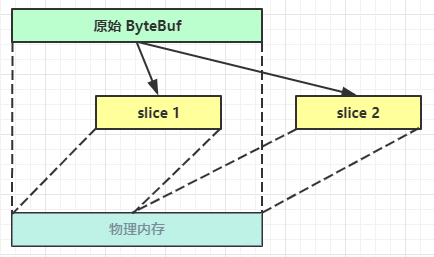<br />例,原始 ByteBuf 进行一些初始操作
ByteBuf origin = ByteBufAllocator.DEFAULT.buffer(10); origin.writeBytes(new byte[]{1, 2, 3, 4}); origin.readByte(); System.out.println(ByteBufUtil.prettyHexDump(origin));
输出
+-------------------------------------------------+| 0 1 2 3 4 5 6 7 8 9 a b c d e f |
+————+————————————————————————-+————————+ |00000000| 02 03 04 |… | +————+————————————————————————-+————————+
这时调用 slice 进行切片,无参 slice 是从原始 ByteBuf 的 read index 到 write index 之间的内容进行切片,切片后的 max capacity 被固定为这个区间的大小,因此不能追加 write
ByteBuf slice = origin.slice(); System.out.println(ByteBufUtil.prettyHexDump(slice)); // slice.writeByte(5); 如果执行,会报 IndexOutOfBoundsException 异常
输出
+-------------------------------------------------+| 0 1 2 3 4 5 6 7 8 9 a b c d e f |
+————+————————————————————————-+————————+ |00000000| 02 03 04 |… | +————+————————————————————————-+————————+
如果原始 ByteBuf 再次读操作(又读了一个字节)
origin.readByte(); System.out.println(ByteBufUtil.prettyHexDump(origin));
输出
+-------------------------------------------------+| 0 1 2 3 4 5 6 7 8 9 a b c d e f |
+————+————————————————————————-+————————+ |00000000| 03 04 |.. | +————+————————————————————————-+————————+
这时的 slice 不受影响,因为它有独立的读写指针
System.out.println(ByteBufUtil.prettyHexDump(slice));
输出
+-------------------------------------------------+| 0 1 2 3 4 5 6 7 8 9 a b c d e f |
+————+————————————————————————-+————————+ |00000000| 02 03 04 |… | +————+————————————————————————-+————————+
如果 slice 的内容发生了更改
slice.setByte(2, 5); System.out.println(ByteBufUtil.prettyHexDump(slice));
输出
+-------------------------------------------------+| 0 1 2 3 4 5 6 7 8 9 a b c d e f |
+————+————————————————————————-+————————+ |00000000| 02 03 05 |… | +————+————————————————————————-+————————+
这时,原始 ByteBuf 也会受影响,因为底层都是同一块内存
System.out.println(ByteBufUtil.prettyHexDump(origin));
输出
+-------------------------------------------------+| 0 1 2 3 4 5 6 7 8 9 a b c d e f |
+————+————————————————————————-+————————+ |00000000| 03 05 |.. | +————+————————————————————————-+————————+
#### 10)duplicate【零拷贝】的体现之一,就好比截取了原始 ByteBuf 所有内容,并且没有 max capacity 的限制,也是与原始 ByteBuf 使用同一块底层内存,只是读写指针是独立的<br />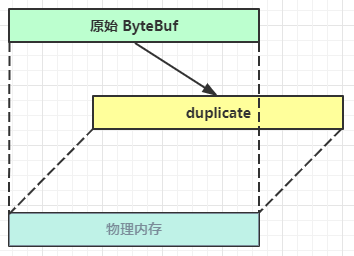#### 11)copy会将底层内存数据进行深拷贝,因此无论读写,都与原始 ByteBuf 无关#### 12)CompositeByteBuf【零拷贝】的体现之一,可以将多个 ByteBuf 合并为一个逻辑上的 ByteBuf,避免拷贝<br />有两个 ByteBuf 如下
ByteBuf buf1 = ByteBufAllocator.DEFAULT.buffer(5); buf1.writeBytes(new byte[]{1, 2, 3, 4, 5}); ByteBuf buf2 = ByteBufAllocator.DEFAULT.buffer(5); buf2.writeBytes(new byte[]{6, 7, 8, 9, 10}); System.out.println(ByteBufUtil.prettyHexDump(buf1)); System.out.println(ByteBufUtil.prettyHexDump(buf2));
输出
+-------------------------------------------------+| 0 1 2 3 4 5 6 7 8 9 a b c d e f |
+————+————————————————————————-+————————+ |00000000| 01 02 03 04 05 |….. | +————+————————————————————————-+————————+ +————————————————————————-+ | 0 1 2 3 4 5 6 7 8 9 a b c d e f | +————+————————————————————————-+————————+ |00000000| 06 07 08 09 0a |….. | +————+————————————————————————-+————————+
现在需要一个新的 ByteBuf,内容来自于刚才的 buf1 和 buf2,如何实现?<br />方法1:
ByteBuf buf3 = ByteBufAllocator.DEFAULT .buffer(buf1.readableBytes()+buf2.readableBytes()); buf3.writeBytes(buf1); buf3.writeBytes(buf2); System.out.println(ByteBufUtil.prettyHexDump(buf3));
结果
+-------------------------------------------------+| 0 1 2 3 4 5 6 7 8 9 a b c d e f |
+————+————————————————————————-+————————+ |00000000| 01 02 03 04 05 06 07 08 09 0a |………. | +————+————————————————————————-+————————+
这种方法好不好?回答是不太好,因为进行了数据的内存复制操作<br />方法2:
CompositeByteBuf buf3 = ByteBufAllocator.DEFAULT.compositeBuffer(); // true 表示增加新的 ByteBuf 自动递增 write index, 否则 write index 会始终为 0 buf3.addComponents(true, buf1, buf2);
结果是一样的
+-------------------------------------------------+| 0 1 2 3 4 5 6 7 8 9 a b c d e f |
+————+————————————————————————-+————————+ |00000000| 01 02 03 04 05 06 07 08 09 0a |………. | +————+————————————————————————-+————————+
CompositeByteBuf 是一个组合的 ByteBuf,它内部维护了一个 Component 数组,每个 Component 管理一个 ByteBuf,记录了这个 ByteBuf 相对于整体偏移量等信息,代表着整体中某一段的数据。- 优点,对外是一个虚拟视图,组合这些 ByteBuf 不会产生内存复制- 缺点,复杂了很多,多次操作会带来性能的损耗#### 13)UnpooledUnpooled 是一个工具类,类如其名,提供了非池化的 ByteBuf 创建、组合、复制等操作<br />这里仅介绍其跟【零拷贝】相关的 wrappedBuffer 方法,可以用来包装 ByteBuf
ByteBuf buf1 = ByteBufAllocator.DEFAULT.buffer(5); buf1.writeBytes(new byte[]{1, 2, 3, 4, 5}); ByteBuf buf2 = ByteBufAllocator.DEFAULT.buffer(5); buf2.writeBytes(new byte[]{6, 7, 8, 9, 10});
// 当包装 ByteBuf 个数超过一个时, 底层使用了 CompositeByteBuf ByteBuf buf3 = Unpooled.wrappedBuffer(buf1, buf2); System.out.println(ByteBufUtil.prettyHexDump(buf3));
输出
+-------------------------------------------------+| 0 1 2 3 4 5 6 7 8 9 a b c d e f |
+————+————————————————————————-+————————+ |00000000| 01 02 03 04 05 06 07 08 09 0a |………. | +————+————————————————————————-+————————+
也可以用来包装普通字节数组,底层也不会有拷贝操作
ByteBuf buf4 = Unpooled.wrappedBuffer(new byte[]{1, 2, 3}, new byte[]{4, 5, 6}); System.out.println(buf4.getClass()); System.out.println(ByteBufUtil.prettyHexDump(buf4));
输出
class io.netty.buffer.CompositeByteBuf +————————————————————————-+ | 0 1 2 3 4 5 6 7 8 9 a b c d e f | +————+————————————————————————-+————————+ |00000000| 01 02 03 04 05 06 |…… | +————+————————————————————————-+————————+
#### 💡 ByteBuf 优势- 池化 - 可以重用池中 ByteBuf 实例,更节约内存,减少内存溢出的可能- 读写指针分离,不需要像 ByteBuffer 一样切换读写模式- 可以自动扩容- 支持链式调用,使用更流畅- 很多地方体现零拷贝,例如 slice、duplicate、CompositeByteBuf## 4. 双向通信### 4.1 练习实现一个 echo server<br />编写 server
new ServerBootstrap()
.group(new NioEventLoopGroup())
.channel(NioServerSocketChannel.class)
.childHandler(new ChannelInitializer
// 建议使用 ctx.alloc() 创建 ByteBufByteBuf response = ctx.alloc().buffer();response.writeBytes(buffer);ctx.writeAndFlush(response);// 思考:需要释放 buffer 吗// 思考:需要释放 response 吗}});}}).bind(8080);
编写 client
NioEventLoopGroup group = new NioEventLoopGroup();
Channel channel = new Bootstrap()
.group(group)
.channel(NioSocketChannel.class)
.handler(new ChannelInitializer
// 思考:需要释放 buffer 吗}});}}).connect("127.0.0.1", 8080).sync().channel();
channel.closeFuture().addListener(future -> { group.shutdownGracefully(); });
new Thread(() -> { Scanner scanner = new Scanner(System.in); while (true) { String line = scanner.nextLine(); if (“q”.equals(line)) { channel.close(); break; } channel.writeAndFlush(line); } }).start();
### 💡 读和写的误解我最初在认识上有这样的误区,认为只有在 netty,nio 这样的多路复用 IO 模型时,读写才不会相互阻塞,才可以实现高效的双向通信,但实际上,Java Socket 是全双工的:在任意时刻,线路上存在`A 到 B` 和 `B 到 A` 的双向信号传输。即使是阻塞 IO,读和写是可以同时进行的,只要分别采用读线程和写线程即可,读不会阻塞写、写也不会阻塞读<br />例如
public class TestServer { public static void main(String[] args) throws IOException { ServerSocket ss = new ServerSocket(8888); Socket s = ss.accept();
new Thread(() -> {try {BufferedReader reader = new BufferedReader(new InputStreamReader(s.getInputStream()));while (true) {System.out.println(reader.readLine());}} catch (IOException e) {e.printStackTrace();}}).start();new Thread(() -> {try {BufferedWriter writer = new BufferedWriter(new OutputStreamWriter(s.getOutputStream()));// 例如在这个位置加入 thread 级别断点,可以发现即使不写入数据,也不妨碍前面线程读取客户端数据for (int i = 0; i < 100; i++) {writer.write(String.valueOf(i));writer.newLine();writer.flush();}} catch (IOException e) {e.printStackTrace();}}).start();}
}
客户端
public class TestClient { public static void main(String[] args) throws IOException { Socket s = new Socket(“localhost”, 8888);
new Thread(() -> {try {BufferedReader reader = new BufferedReader(new InputStreamReader(s.getInputStream()));while (true) {System.out.println(reader.readLine());}} catch (IOException e) {e.printStackTrace();}}).start();new Thread(() -> {try {BufferedWriter writer = new BufferedWriter(new OutputStreamWriter(s.getOutputStream()));for (int i = 0; i < 100; i++) {writer.write(String.valueOf(i));writer.newLine();writer.flush();}} catch (IOException e) {e.printStackTrace();}}).start();}
}
```

